Flanges
- Home
- Flanges
Flanges
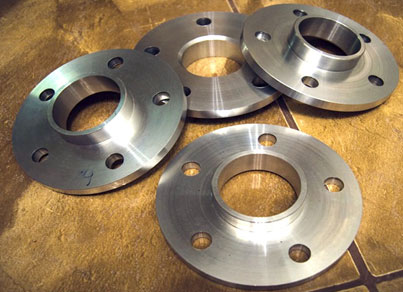
Nickel Alloy Flanges
Scope of Alloy Pipe Impex nickel flanges are perfect for application in various industry
for high weight and temperature applications. These flanges are composed with exactness for
simple establishment. Aside from standard flanges, we likewise offer hand crafted nickel
flanges to meet the particular application prerequisites of the clients.
Item Code: 7219
Port Of Dispatch: Any
Production Capacity: Ready Stock
Packaging Details: As Per Customer Requirment
| Specification | EN Standard | Grade | Chemical Composition | Description |
|---|---|---|---|---|
| Nickel 200 | EN 2.4060 | UNS N02200 | Ni: 99.0% min, Fe: 0.4% max, Cu: 0.3% max, C: 0.15% max, Mn: 0.35% max, S: 0.01% max, Si: 0.35% max | Pure nickel with excellent corrosion resistance and good mechanical properties. Used in chemical processing and aerospace applications. |
| Nickel 201 | EN 2.4061 | UNS N02201 | Ni: 99.0% min, Fe: 0.4% max, Cu: 0.3% max, C: 0.02% max, Mn: 0.35% max, S: 0.01% max, Si: 0.35% max | Similar to Nickel 200 but with lower carbon content for better resistance to embrittlement. Used in food processing and nuclear applications. |
| Inconel 600 | EN 2.4816 | UNS N06600 | Ni: 72.0-78.0%, Cr: 14.0-17.0%, Fe: Balance, C: 0.15% max, Mn: 1.0% max, Si: 0.5% max, S: 0.015% max | Nickel-chromium alloy with excellent oxidation and corrosion resistance at high temperatures. Used in gas turbines and chemical processing. |
| Inconel 625 | EN 2.4856 | UNS N06625 | Ni: 58.0-63.0%, Cr: 20.0-23.0%, Mo: 8.0-10.0%, Nb: 3.15-4.15%, Fe: Balance, C: 0.10% max | Nickel-chromium-molybdenum alloy with exceptional fatigue and thermal-fatigue strength. Used in aerospace, marine, and chemical processing industries. |
| Hastelloy C-276 | EN 2.4819 | UNS N10276 | Ni: 57.0-63.0%, Cr: 14.5-16.5%, Mo: 15.0-17.0%, W: 3.0-4.5%, Fe: Balance, C: 0.01% max, Si: 0.08% max | Nickel-molybdenum-chromium alloy with outstanding resistance to oxidation and corrosion. Ideal for harsh chemical environments and high-temperature applications. |
| Hastelloy B-3 | EN 2.4668 | UNS N10675 | Ni: 62.0-72.0%, Mo: 28.0-31.0%, Fe: Balance, C: 0.02% max, Cr: 0.2% max, Si: 0.5% max | Nickel-molybdenum alloy with excellent resistance to hydrochloric acid and other corrosive environments. Used in chemical processing and pollution control equipment. |
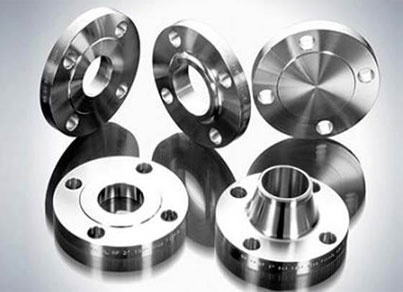
Monel Alloy Flanges
We are offering Monel Alloy Flanges to our clients. Contact us for more consultation and orders.
Production Capacity: 70,000 Metric Tons
Port Of Dispatch: Any
Delivery Time: Ready Stock
Packaging Details: As Per Buyer's Requirement
| Specification | EN Standard | Grade | Chemical Composition | Description |
|---|---|---|---|---|
| Monel 400 | EN 2.4360 | UNS N04400 | Ni: 63.0-70.0%, Cu: 28.0-34.0%, Fe: 2.5% max, Mn: 2.0% max, Si: 0.5% max, C: 0.3% max | Nickel-copper alloy with excellent resistance to seawater and various acids. Used in marine and chemical processing applications. |
| Monel K500 | EN 2.4375 | UNS N05500 | Ni: 63.0-70.0%, Cu: 27.0-33.0%, Fe: 2.0% max, Mn: 1.5% max, Si: 0.5% max, C: 0.25% max, Al: 2.3-3.15%, Ti: 0.35-0.85% | Nickel-copper alloy with added aluminum and titanium for improved strength and hardness. Used in marine, oil and gas, and pump applications. |
| Monel 404 | EN 2.4373 | UNS N04404 | Ni: 63.0-70.0%, Cu: 28.0-34.0%, Fe: 1.5% max, C: 0.3% max, Mn: 0.5% max, Si: 0.5% max | Similar to Monel 400 but with lower iron content for improved corrosion resistance. Ideal for chemical processing and marine applications. |
| Monel 452 | EN 2.4610 | UNS N04520 | Ni: 65.0-70.0%, Cu: 24.0-29.0%, Cr: 1.0-1.5%, Fe: 3.0% max, C: 0.2% max, Mn: 1.0% max, Si: 0.5% max | Nickel-copper alloy with added chromium for improved oxidation resistance. Used in aerospace and marine applications. |
| Monel 4865 | EN 2.4380 | UNS N06625 | Ni: 59.0-63.0%, Cu: 22.0-26.0%, Fe: 2.0% max, C: 0.15% max, Mn: 1.0% max, Si: 0.5% max | Nickel-copper alloy with high strength and good resistance to corrosion and oxidation. Suitable for marine and chemical processing industries. |
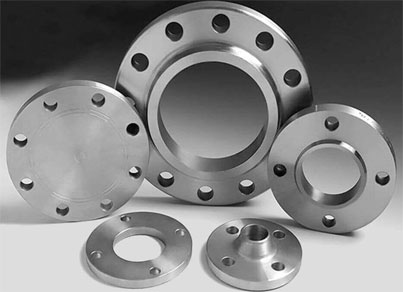
Inconel Flanges
Inconel flanges can withstand high temperatures, making them ideal for applications in environments with extreme heat, such as gas turbines and exhaust systems.
The nickel content in Inconel provides excellent resistance to oxidation and corrosion, even in harsh environments like seawater, acidic, and alkaline environments.
Inconel forms a protective oxide layer when exposed to high temperatures, which helps to prevent further oxidation.
Inconel 600:
Good oxidation and corrosion resistance at higher temperatures.
Commonly used in chemical and food processing, nuclear engineering, and the aerospace industry.
| Specification | EN Standard | Grade | Chemical Composition | Description |
|---|---|---|---|---|
| Inconel 600 | EN 2.4816 | UNS N06600 | Ni: 72.0-78.0%, Cr: 14.0-17.0%, Fe: Balance, C: 0.15% max, Mn: 1.0% max, Si: 0.5% max, S: 0.015% max | Nickel-chromium alloy with excellent oxidation and corrosion resistance at high temperatures. Used in gas turbines and chemical processing. |
| Inconel 601 | EN 2.4851 | UNS N06601 | Ni: 58.0-63.0%, Cr: 21.0-25.0%, Fe: Balance, C: 0.10% max, Mn: 1.0% max, Si: 0.5% max, S: 0.015% max | Nickel-chromium-iron alloy with outstanding resistance to oxidation and carburization. Ideal for furnace components and chemical processing equipment. |
| Inconel 625 | EN 2.4856 | UNS N06625 | Ni: 58.0-63.0%, Cr: 20.0-23.0%, Mo: 8.0-10.0%, Nb: 3.15-4.15%, Fe: Balance, C: 0.10% max | Nickel-chromium-molybdenum alloy with high fatigue and thermal-fatigue strength. Used in aerospace, marine, and chemical processing industries. |
| Inconel 718 | EN 2.4668 | UNS N07718 | Ni: 50.0-55.0%, Cr: 17.0-21.0%, Fe: Balance, Mo: 2.8-3.3%, Nb: 4.75-5.5%, Ti: 0.65-1.15%, Al: 0.2-0.8% | Nickel-chromium alloy with high strength and oxidation resistance at elevated temperatures. Commonly used in aerospace and nuclear applications. |
| Inconel 925 | EN 2.4669 | UNS N09925 | Ni: 43.0-46.0%, Cr: 19.0-22.0%, Mo: 8.0-9.0%, Fe: Balance, Cu: 0.5% max, C: 0.05% max, Mn: 1.0% max | Nickel-chromium-molybdenum alloy with excellent resistance to oxidation and corrosion. Suitable for oil and gas, chemical processing, and marine environments. |
| Inconel X-750 | EN 2.4669 | UNS N07750 | Ni: 70.0-75.0%, Cr: 14.0-17.0%, Fe: Balance, Mo: 2.8-3.3%, Ti: 1.0-1.5%, Al: 0.2-0.6% | Nickel-chromium alloy with good oxidation and corrosion resistance at high temperatures. Used in gas turbines, jet engines, and nuclear reactors. |
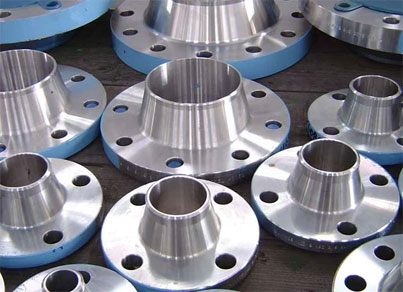
Hastelloy Flanges
Hastelloy is a high-performance nickel-molybdenum-chromium superalloy known for its exceptional resistance to corrosion, especially in harsh chemical environments. Hastelloy flanges are critical components in industries that demand materials capable of withstanding extreme conditions, including high temperatures and corrosive substances.
Hastelloy C-276:
Excellent resistance to pitting, stress-corrosion cracking, and oxidizing atmospheres up to 1900°F (1038°C).
Commonly used in chemical processing, pollution control, and waste treatment.
Hastelloy C-22:
Superior resistance to corrosion, especially in oxidizing environments.
Widely used in pharmaceutical, food processing, and petrochemical industries.
| Specification | EN Standard | Grade | Chemical Composition | Description |
|---|---|---|---|---|
| Hastelloy B-3 | EN 2.4668 | UNS N10675 | Ni: 62.0-72.0%, Mo: 28.0-31.0%, Fe: Balance, C: 0.02% max, Cr: 0.2% max, Si: 0.5% max | Nickel-molybdenum alloy with excellent resistance to hydrochloric acid and other corrosive environments. Used in chemical processing and pollution control equipment. |
| Hastelloy C-276 | EN 2.4819 | UNS N10276 | Ni: 57.0-63.0%, Cr: 14.5-16.5%, Mo: 15.0-17.0%, W: 3.0-4.5%, Fe: Balance, C: 0.01% max, Si: 0.08% max | Nickel-molybdenum-chromium alloy with outstanding resistance to oxidation and corrosion. Ideal for harsh chemical environments and high-temperature applications. |
| Hastelloy C-22 | EN 2.4602 | UNS N06022 | Ni: 56.0-63.0%, Cr: 20.0-22.0%, Mo: 12.5-15.5%, W: 2.0-3.0%, Fe: Balance, C: 0.01% max, Si: 0.08% max | Nickel-chromium-molybdenum-tungsten alloy with superior resistance to oxidizing and reducing environments. Used in chemical processing, aerospace, and marine applications. |
| Hastelloy X | EN 2.4665 | UNS N06002 | Ni: 47.0-52.0%, Cr: 20.0-22.0%, Mo: 8.0-10.0%, Fe: Balance, C: 0.15% max, Mn: 1.0% max, Si: 0.5% max | Nickel-chromium-molybdenum alloy with excellent oxidation and carburization resistance at high temperatures. Commonly used in jet engines and gas turbines. |
| Hastelloy B-2 | EN 2.4617 | UNS N10665 | Ni: 61.0-71.0%, Mo: 28.0-32.0%, Fe: Balance, C: 0.02% max, Cr: 0.3% max, Si: 0.5% max | Nickel-molybdenum alloy with high resistance to hydrochloric acid and other aggressive chemicals. Suitable for chemical processing and industrial applications. |

Super Duplex Flanges
Super Duplex stainless steel is a type of advanced stainless steel known for its excellent corrosion resistance, high strength, and resistance to stress corrosion cracking. It is composed of a mixed microstructure of austenite and ferrite, typically in a 50/50 ratio.
Super Duplex 2507 (UNS S32750):
Contains approximately 25% chromium, 4% molybdenum, and 7% nickel.
Excellent general corrosion resistance and strength.
Super Duplex 32760 (UNS S32760):
Similar composition to 2507 with the addition of tungsten for improved pitting resistance.
Often used in oil and gas applications.
| Specification | EN Standard | Grade | Chemical Composition | Description |
|---|---|---|---|---|
| Super Duplex S32750 | EN 1.4410 | UNS S32750 | Ni: 6.0-8.0%, Cr: 24.0-26.0%, Mo: 3.0-5.0%, N: 0.2-0.3%, Fe: Balance, C: 0.03% max, Mn: 1.0% max, Si: 1.0% max | High-strength, corrosion-resistant alloy with excellent resistance to pitting and crevice corrosion. Used in marine, oil and gas, and chemical processing industries. |
| Super Duplex S32760 | EN 1.4501 | UNS S32760 | Ni: 8.0-9.5%, Cr: 24.0-26.0%, Mo: 3.0-4.0%, N: 0.2-0.3%, Fe: Balance, C: 0.03% max, Mn: 1.0% max, Si: 1.0% max | Highly corrosion-resistant alloy with improved resistance to stress corrosion cracking and high strength. Commonly used in chemical processing and petrochemical industries. |
| Super Duplex S32550 | EN 1.4462 | UNS S32550 | Ni: 6.0-8.0%, Cr: 24.0-26.0%, Mo: 3.0-4.0%, N: 0.2-0.3%, Fe: Balance, C: 0.03% max, Mn: 1.0% max, Si: 1.0% max | High-strength, corrosion-resistant alloy with excellent resistance to pitting and crevice corrosion. Ideal for marine and chemical processing applications. |
| Super Duplex S32906 | EN 1.4529 | UNS S32906 | Ni: 8.0-10.0%, Cr: 24.0-26.0%, Mo: 6.0-7.5%, N: 0.2-0.3%, Fe: Balance, C: 0.03% max, Mn: 1.0% max, Si: 1.0% max | Superior corrosion-resistant alloy with enhanced resistance to acidic environments. Used in chemical and petrochemical industries, as well as seawater applications. |
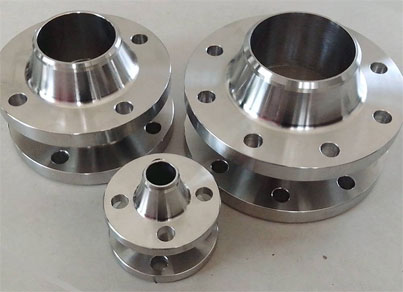
Duplex Steel Flanges
Duplex flanges are made from an austenitic-ferritic stainless steel, which was designed to deliver higher strength and corrosion resistance than other 300 series stainless steel flanges. It helps users to avoid stress corrosion, cracking that is typically seen with 316 and 317. The advantages of duplex stainless steel – higher strength, better fatigue properties, high resistance to chloride stress corrosion cracking etc.
| Specification | EN Standard | Grade | Chemical Composition | Description |
|---|---|---|---|---|
| Duplex S32205 | EN 1.4462 | UNS S32205 | Ni: 4.5-6.5%, Cr: 21.0-23.0%, Mo: 2.5-3.5%, N: 0.08-0.2%, Fe: Balance, C: 0.03% max, Mn: 1.0% max, Si: 1.0% max | Duplex stainless steel with high strength and good resistance to pitting, crevice corrosion, and stress corrosion cracking. Used in chemical processing, oil and gas, and marine environments. |
| Duplex S32101 | EN 1.4162 | UNS S32101 | Ni: 3.0-5.0%, Cr: 21.0-23.0%, Mo: 0.3-0.6%, N: 0.1-0.2%, Fe: Balance, C: 0.03% max, Mn: 1.0% max, Si: 1.0% max | Lower alloyed duplex stainless steel with good resistance to corrosion and high strength. Ideal for less severe environments and cost-effective applications. |
| Duplex S32750 | EN 1.4410 | UNS S32750 | Ni: 6.0-8.0%, Cr: 24.0-26.0%, Mo: 3.0-5.0%, N: 0.2-0.3%, Fe: Balance, C: 0.03% max, Mn: 1.0% max, Si: 1.0% max | High-strength duplex stainless steel with excellent resistance to pitting and crevice corrosion. Suitable for harsh marine and chemical processing environments. |
| Duplex S32900 | EN 1.4529 | UNS S32900 | Ni: 8.0-10.0%, Cr: 24.0-26.0%, Mo: 6.0-7.5%, N: 0.2-0.3%, Fe: Balance, C: 0.03% max, Mn: 1.0% max, Si: 1.0% max | High-alloy duplex stainless steel with superior resistance to corrosion and high strength. Used in highly corrosive environments such as chemical and petrochemical industries. |
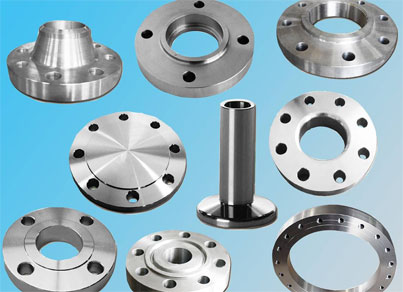
Stainless Steel Flanges
Stainless steel Flanges are widely used in both domestic and industrial applications because of the various benefits it offers. It is resistant to corrosion and temperature and appearance is good. The flanges made of stainless steel offers all these benefits and many more. Stainless steel flanges are important in industries like transport, gas, water, food, beverage, chemical process etc where piping is required these flanges are used for connections. Flanges are important part of the piping connection and also provides easy access for cleaning, inspection or modification.
| Specification | EN Standard | UNS Number | Chemical Composition | Description |
|---|---|---|---|---|
| Stainless Steel 304 | EN 1.4301 | UNS S30400 | Ni: 8.0-10.5%, Cr: 18.0-20.0%, Fe: Balance, C: 0.08% max, Mn: 2.0% max, Si: 1.0% max, S: 0.03% max | Versatile stainless steel with good corrosion resistance and formability. Widely used in kitchen equipment, chemical processing, and architectural applications. |
| Stainless Steel 316 | EN 1.4401 | UNS S31600 | Ni: 10.0-14.0%, Cr: 16.0-18.0%, Mo: 2.0-3.0%, Fe: Balance, C: 0.08% max, Mn: 2.0% max, Si: 1.0% max | Corrosion-resistant stainless steel with added molybdenum for better resistance to chloride environments. Ideal for marine, chemical, and medical applications. |
| Stainless Steel 321 | EN 1.4541 | UNS S32100 | Ni: 9.0-12.0%, Cr: 17.0-19.0%, Ti: 5xC min, Fe: Balance, C: 0.08% max, Mn: 2.0% max, Si: 1.0% max | Stainless steel with titanium stabilization for improved high-temperature resistance. Used in aircraft, chemical processing, and exhaust systems. |
| Stainless Steel 347 | EN 1.4550 | UNS S34700 | Ni: 9.0-13.0%, Cr: 17.0-19.0%, Nb: 10xC min, Fe: Balance, C: 0.08% max, Mn: 2.0% max, Si: 1.0% max | Stainless steel with niobium added for better resistance to intergranular corrosion. Suitable for high-temperature applications and chemical processing. |
| Stainless Steel 316L | EN 1.4404 | UNS S31603 | Ni: 10.0-14.0%, Cr: 16.0-18.0%, Mo: 2.0-3.0%, Fe: Balance, C: 0.03% max, Mn: 2.0% max, Si: 1.0% max | Low-carbon version of 316 stainless steel with enhanced resistance to corrosion and weldability. Commonly used in medical devices, marine environments, and chemical processing. |
| Stainless Steel 310 | EN 1.4845 | UNS S31000 | Ni: 19.0-22.0%, Cr: 24.0-26.0%, Fe: Balance, C: 0.25% max, Mn: 2.0% max, Si: 1.5% max | High-temperature stainless steel with good oxidation resistance and high strength. Used in furnace parts, heat exchangers, and high-temperature applications. |
| Stainless Steel 304H | EN 1.4948 | UNS S30409 | Ni: 8.0-10.5%, Cr: 18.0-20.0%, Fe: Balance, C: 0.04-0.10%, Mn: 2.0% max, Si: 1.0% max | High carbon version of 304 for improved strength at elevated temperatures. Used in high-temperature applications like heat exchangers and boilers. |
| Stainless Steel 316H | EN 1.4919 | UNS S31609 | Ni: 10.0-14.0%, Cr: 16.0-18.0%, Mo: 2.0-3.0%, Fe: Balance, C: 0.04-0.10%, Mn: 2.0% max, Si: 1.0% max | High carbon version of 316 for improved strength at elevated temperatures. Used in chemical processing, high-temperature industrial applications. |
| Stainless Steel 316LN | EN 1.4429 | UNS S31653 | Ni: 10.0-14.0%, Cr: 16.0-18.0%, Mo: 2.0-3.0%, N: 0.10-0.16%, Fe: Balance, C: 0.03% max, Mn: 2.0% max, Si: 1.0% max | Low-carbon, nitrogen-enhanced version of 316 for superior resistance to pitting and crevice corrosion. Used in marine and chemical environments. |
| Stainless Steel 316Ti | EN 1.4571 | UNS S31635 | Ni: 10.0-14.0%, Cr: 16.0-18.0%, Mo: 2.0-3.0%, Ti: 5xC min, Fe: Balance, C: 0.08% max, Mn: 2.0% max, Si: 1.0% max | Titanium-stabilized version of 316 for improved resistance to sensitization. Used in high-temperature and welded applications. |
| Stainless Steel 317 | EN 1.4449 | UNS S31700 | Ni: 11.0-15.0%, Cr: 18.0-20.0%, Mo: 3.0-4.0%, Fe: Balance, C: 0.08% max, Mn: 2.0% max, Si: 1.0% max | Enhanced molybdenum content for improved corrosion resistance. Used in chemical and petrochemical processing. |
| Stainless Steel 317L | EN 1.4438 | UNS S31703 | Ni: 11.0-15.0%, Cr: 18.0-20.0%, Mo: 3.0-4.0%, Fe: Balance, C: 0.03% max, Mn: 2.0% max, Si: 1.0% max | Low-carbon version of 317 for improved weldability and corrosion resistance. Used in chemical processing and high-corrosion environments. |
| Stainless Steel 321H | EN 1.4878 | UNS S32109 | Ni: 9.0-12.0%, Cr: 17.0-19.0%, Ti: 5xC min, Fe: Balance, C: 0.04-0.10%, Mn: 2.0% max, Si: 1.0% max | High carbon version of 321 for improved high-temperature strength. Used in high-temperature chemical processing and aerospace applications. |
| Stainless Steel 347H | EN 1.4961 | UNS S34709 | Ni: 9.0-13.0%, Cr: 17.0-19.0%, Nb: 10xC min, Fe: Balance, C: 0.04-0.10%, Mn: 2.0% max, Si: 1.0% max | High carbon version of 347 for improved high-temperature strength. Used in high-temperature chemical processing and aerospace applications. |
| Stainless Steel 17-4PH | EN 1.4542 | UNS S17400 | Ni: 3.0-5.0%, Cr: 15.0-17.5%, Cu: 3.0-5.0%, Nb: 0.15-0.45%, Fe: Balance, C: 0.07% max, Mn: 1.0% max, Si: 1.0% max | Precipitation-hardening stainless steel with high strength and good corrosion resistance. Used in aerospace, chemical processing, and petrochemical applications. |
| Stainless Steel 410 | EN 1.4006 | UNS S41000 | Ni: 0.75% max, Cr: 11.5-13.5%, Fe: Balance, C: 0.15% max, Mn: 1.0% max, Si: 1.0% max | Martensitic stainless steel with moderate corrosion resistance and good hardness. Suitable for cutlery, valves, and pumps. |
| Stainless Steel 431 | EN 1.4057 | UNS S43100 | Ni: 1.25-2.50%, Cr: 15.0-17.0%, Fe: Balance, C: 0.20% max, Mn: 1.0% max, Si: 1.0% max | Martensitic stainless steel with high strength and good corrosion resistance. Used in aerospace, marine, and high-stress components. |
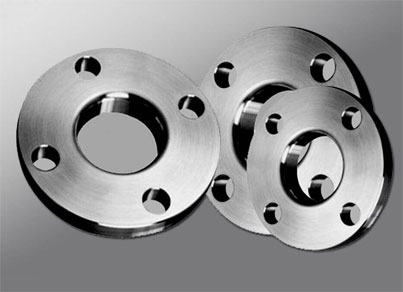
Alloy Steel Flanges
Alloy steel flanges offer high tensile and yield strength, making them suitable for high-pressure applications.
Durability:
Excellent resistance to wear and tear, providing long service life even in harsh conditions.
Temperature Resistance:
Capable of withstanding high temperatures without losing strength or integrity.
A182 F1:
Contains molybdenum for increased strength and corrosion resistance.
Used in high-temperature service applications.
A182 F5:
Contains chromium and molybdenum, offering good resistance to oxidation and corrosion.
Suitable for high-temperature service in oil refineries and power plants.
A182 F9:
Contains higher chromium and molybdenum content for better corrosion and oxidation resistance.
Ideal for high-pressure and high-temperature applications.
| Specification | EN Standard | Grade | Chemical Composition | Description |
|---|---|---|---|---|
| Alloy Steel 4130 | EN 1.7218 | UNS G41300 | Ni: 0.30-0.60%, Cr: 0.80-1.10%, Mo: 0.15-0.25%, Fe: Balance, C: 0.28-0.33%, Mn: 0.60-0.90%, Si: 0.15-0.35% | Chromium-molybdenum alloy steel with good fatigue strength and impact resistance. Used in aerospace, automotive, and structural applications. |
| Alloy Steel 4140 | EN 1.7225 | UNS G41400 | Ni: 0.30-0.60%, Cr: 0.80-1.10%, Mo: 0.15-0.25%, Fe: Balance, C: 0.38-0.43%, Mn: 0.75-1.00%, Si: 0.15-0.35% | Chromium-molybdenum alloy steel with high strength and toughness. Commonly used in gears, axles, and shafts. |
| Alloy Steel 4340 | EN 1.6511 | UNS G43400 | Ni: 1.65-2.00%, Cr: 0.80-1.10%, Mo: 0.15-0.25%, Fe: Balance, C: 0.36-0.44%, Mn: 0.60-0.80%, Si: 0.15-0.35% | Nickel-chromium-molybdenum alloy steel with high tensile strength and toughness. Ideal for heavy-duty components like crankshafts and gears. |
| Alloy Steel 8620 | EN 1.6523 | UNS G86200 | Ni: 1.25-1.75%, Cr: 0.50-0.80%, Mo: 0.15-0.25%, Fe: Balance, C: 0.18-0.23%, Mn: 0.70-0.90%, Si: 0.15-0.35% | Nickel-chromium-molybdenum alloy steel with good hardenability and wear resistance. Used in gears, axles, and shafts. |
| Alloy Steel 9310 | EN 1.6580 | UNS G93100 | Ni: 3.25-3.75%, Cr: 0.70-0.90%, Mo: 0.20-0.30%, Fe: Balance, C: 0.18-0.23%, Mn: 0.40-0.60%, Si: 0.15-0.35% | Nickel-chromium-molybdenum alloy steel with high fatigue strength and toughness. Often used in aerospace and automotive components. |
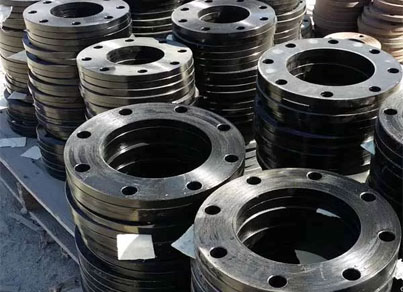
Carbon Steel Flanges
Carbon Steel Flanges are pipe connectors that join two pieces of piping together. They are made using carbon steel material and contain a raised lip or rim that ensures a strong bond is formed between the pipes by welding them together. Furthermore, they are designed to support greater pressure due to their stronger construction. These metallic connections also provide moderate corrosion resistance, making them ideal for industrial & general purpose applications.
| Specification | EN Standard | Grade | Chemical Composition | Description |
|---|---|---|---|---|
| Carbon Steel S235 | EN 1.0038 | UNS K02001 | Ni: 0.00%, Cr: 0.00%, Mn: 0.60-0.90%, Fe: Balance, C: 0.14-0.20%, Si: 0.05-0.35%, P: 0.05% max, S: 0.05% max | Low-carbon structural steel with good weldability and machinability. Used in construction and structural applications. |
| Carbon Steel S275 | EN 1.0044 | UNS K02002 | Ni: 0.00%, Cr: 0.00%, Mn: 0.60-0.90%, Fe: Balance, C: 0.16-0.22%, Si: 0.05-0.35%, P: 0.05% max, S: 0.05% max | Medium-carbon steel with higher strength and toughness compared to S235. Suitable for structural and engineering applications. |
| Carbon Steel S355 | EN 1.0545 | UNS K02003 | Ni: 0.00%, Cr: 0.00%, Mn: 0.60-0.90%, Fe: Balance, C: 0.22-0.28%, Si: 0.05-0.35%, P: 0.05% max, S: 0.05% max | High-strength low-alloy steel with excellent weldability and impact resistance. Used in heavy structural applications. |
| Carbon Steel A106 | EN 1.0503 | UNS K02500 | Ni: 0.00%, Cr: 0.00%, Mn: 0.60-0.90%, Fe: Balance, C: 0.30-0.60%, Si: 0.10-0.35%, P: 0.035% max, S: 0.035% max | High-quality carbon steel for high-temperature service, suitable for pressure vessels and pipelines. |
| Carbon Steel A53 | EN 1.0204 | UNS K02003 | Ni: 0.00%, Cr: 0.00%, Mn: 0.60-0.90%, Fe: Balance, C: 0.25-0.30%, Si: 0.10-0.35%, P: 0.05% max, S: 0.05% max | Carbon steel pipe used for mechanical and pressure applications. Ideal for welding, bending, and flanging. |
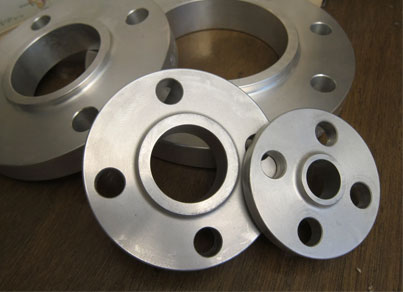
Aluminum Flanges
Aluminum flanges are significantly lighter than steel and other metal flanges, making them easier to handle and install.
Excellent resistance to corrosion, especially in environments exposed to moisture and chemicals. This makes them suitable for marine and chemical applications.
6061:
Known for its excellent mechanical properties and weldability. Suitable for structural applications.
5083:
Offers high strength and exceptional resistance to seawater corrosion. Commonly used in marine applications.
7075:
High strength and good fatigue resistance. Used in aerospace and high-stress applications.
| Specification | EN Standard | Grade | Chemical Composition | Description |
|---|---|---|---|---|
| Aluminum 1050 | EN 1.Designation | UNS A91050 | Ni: 0.0%, Cr: 0.05-0.20%, Mn: 0.0%, Fe: 0.40%, Si: 0.25-0.40%, Cu: 0.05%, Zn: 0.10%, Mg: 0.0%, Ti: 0.05% max | Pure aluminum with high corrosion resistance and good workability. Used in chemical processing and architectural applications. |
| Aluminum 6061 | EN 1.8302 | UNS A96061 | Ni: 0.0%, Cr: 0.04-0.35%, Mn: 0.15-0.40%, Fe: 0.70%, Si: 0.40-0.80%, Cu: 0.15-0.40%, Zn: 0.25%, Mg: 0.80-1.20% | Versatile aluminum alloy with good mechanical properties and corrosion resistance. Commonly used in aerospace, automotive, and structural applications. |
| Aluminum 7075 | EN 3.4365 | UNS A97075 | Ni: 0.0%, Cr: 0.18-0.28%, Mn: 0.3%, Fe: 0.50%, Si: 0.40%, Cu: 4.2-4.7%, Zn: 5.1-6.1%, Mg: 2.1-2.9% | High-strength aluminum alloy with excellent fatigue resistance. Ideal for aerospace and military applications. |
| Aluminum 2024 | EN 3.1355 | UNS A92024 | Ni: 0.0%, Cr: 0.10-0.20%, Mn: 0.30-0.70%, Fe: 0.50%, Si: 0.50%, Cu: 3.8-4.7%, Zn: 0.25%, Mg: 1.2-1.8% | High-strength alloy with good fatigue resistance and machinability. Used in aerospace and military applications. |
| Aluminum 3003 | EN 1.2500 | UNS A93003 | Ni: 0.0%, Cr: 0.10%, Mn: 1.0-1.5%, Fe: 0.70%, Si: 0.60%, Cu: 0.20%, Zn: 0.10%, Mg: 0.0% | Good corrosion resistance and formability. Commonly used in manufacturing chemical equipment and cooking utensils. |
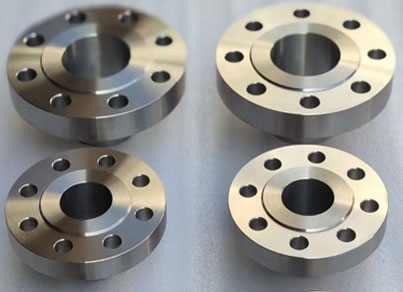
Titanium Flanges
Titanium flanges are highly sought after in various industries due to their exceptional properties, such as high strength-to-weight ratio, corrosion resistance, and biocompatibility. They are particularly useful in environments where both strength and resistance to harsh conditions are required.
High Strength-to-Weight Ratio:
Titanium flanges provide excellent strength while being significantly lighter than steel flanges, making them ideal for applications where weight reduction is crucial.
Corrosion Resistance:
Outstanding resistance to corrosion in seawater, acidic environments, and other aggressive chemicals. This makes them suitable for marine, chemical processing, and offshore applications.
Grade 2 (Commercially Pure Titanium):
Known for its excellent corrosion resistance, weldability, and ductility. Used in chemical processing, marine, and medical applications.
Grade 5 (Ti-6Al-4V):
The most commonly used titanium alloy, known for its high strength, lightweight, and excellent corrosion resistance. Used in aerospace, medical, and high-performance engineering applications.
| Specification | EN Standard | Grade | Chemical Composition | Description |
|---|---|---|---|---|
| Titanium Grade 1 | EN 3.7025 | UNS R50250 | Ni: 0.0%, Cr: 0.0%, Mn: 0.0%, Fe: 0.2%, Si: 0.1%, Cu: 0.0%, Zn: 0.0%, C: 0.08%, N: 0.03%, O: 0.18% | Pure titanium with high corrosion resistance and excellent ductility. Used in chemical processing and marine environments. |
| Titanium Grade 2 | EN 3.7035 | UNS R50400 | Ni: 0.0%, Cr: 0.0%, Mn: 0.0%, Fe: 0.3%, Si: 0.1%, Cu: 0.0%, Zn: 0.0%, C: 0.08%, N: 0.03%, O: 0.25% | Commercially pure titanium with slightly higher strength than Grade 1. Commonly used in aerospace, medical devices, and marine applications. |
| Titanium Grade 5 | EN 3.7165 | UNS R56400 | Ni: 0.0%, Cr: 0.0%, Mn: 0.0%, Fe: 0.3%, Si: 0.1%, Cu: 0.0%, Zn: 0.0%, C: 0.08%, N: 0.05%, O: 0.20%, Al: 4.0-4.5%, V: 3.5-4.5% | Titanium alloy with high strength and good corrosion resistance. Widely used in aerospace, medical implants, and high-performance applications. |
| Titanium Grade 7 | EN 3.7235 | UNS R52400 | Ni: 0.0%, Cr: 0.0%, Mn: 0.0%, Fe: 0.3%, Si: 0.1%, Cu: 0.0%, Zn: 0.0%, C: 0.08%, N: 0.03%, O: 0.25%, Pd: 0.12-0.25% | Alloyed with palladium for increased corrosion resistance. Used in chemical processing and marine environments. |
| Titanium Grade 9 | EN 3.7165 | UNS R56320 | Ni: 0.0%, Cr: 0.0%, Mn: 0.0%, Fe: 0.3%, Si: 0.1%, Cu: 0.0%, Zn: 0.0%, C: 0.08%, N: 0.03%, O: 0.25%, Al: 3.5-4.5%, V: 2.5-3.5% | Titanium-aluminum-vanadium alloy with high strength and good weldability. Used in aerospace, sporting equipment, and industrial applications. |
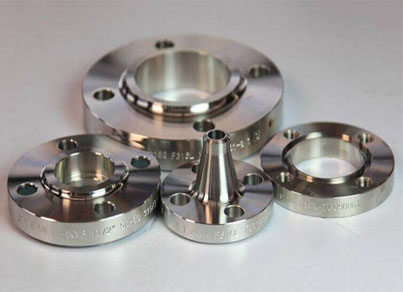
Nimonic Flanges
Nimonic flanges are crucial components in various high-temperature and high-stress applications, renowned for their exceptional heat and corrosion resistance. Nimonic alloys, which are nickel-based superalloys, exhibit remarkable mechanical properties even at elevated temperatures.
High Temperature Resistance:
Nimonic flanges can withstand extreme temperatures, making them ideal for applications in aerospace, gas turbine engines, and industrial furnaces.
Excellent Mechanical Properties:
These alloys retain their mechanical strength even at elevated temperatures, offering good creep and rupture resistance.
Nimonic 75:
Offers good mechanical properties and corrosion resistance at high temperatures. Used in gas turbine engines and industrial heating applications.
Nimonic 80A:
Provides excellent creep and oxidation resistance at temperatures up to 815°C. Widely used in gas turbine components and high-temperature applications.
Nimonic 90:
Known for its high strength and creep resistance at temperatures up to 950°C. Commonly used in aircraft parts and industrial furnace components.
| Specification | EN Standard | Grade | Chemical Composition | Description |
|---|---|---|---|---|
| Nimonic 75 | EN 2.4630 | UNS N06075 | Ni: Balance, Cr: 14.0-16.0%, Co: 1.0%, Mo: 1.5-2.5%, Al: 1.0-1.5%, Ti: 2.0-3.0%, Fe: 0.50% max, C: 0.10% max | Nickel-chromium-cobalt alloy with high strength and oxidation resistance at high temperatures. Used in turbine blades and high-temperature applications. |
| Nimonic 80A | EN 2.4952 | UNS N07080 | Ni: Balance, Cr: 19.0-21.0%, Co: 1.0%, Mo: 1.5%, Al: 1.0-1.5%, Ti: 2.5-3.0%, Fe: 0.50% max, C: 0.08% max | Nickel-chromium alloy with high strength and resistance to oxidation and carburization. Suitable for gas turbines and aerospace components. |
| Nimonic 90 | EN 2.4631 | UNS N07090 | Ni: Balance, Cr: 19.0-21.0%, Co: 0.5%, Mo: 2.0-3.0%, Al: 1.0-1.5%, Ti: 1.5-2.0%, Fe: 0.50% max, C: 0.08% max | Nickel-chromium alloy with improved high-temperature strength and resistance to thermal fatigue. Used in aerospace and industrial gas turbines. |
| Nimonic 263 | EN 2.4663 | UNS N07263 | Ni: Balance, Cr: 20.0-22.0%, Co: 10.0-12.0%, Mo: 3.5-4.5%, Al: 0.8-1.3%, Ti: 0.6-1.0%, Fe: 1.0% max, C: 0.10% max | Nickel-chromium-cobalt-molybdenum alloy with high strength and excellent resistance to oxidation and thermal fatigue. Ideal for turbine blades and high-temperature applications. |
| Nimonic 105 | EN 2.4633 | UNS N06005 | Ni: Balance, Cr: 14.0-16.0%, Co: 0.0%, Mo: 1.5%, Al: 0.4-0.6%, Ti: 1.0-1.5%, Fe: 0.50% max, C: 0.10% max | Nickel-chromium alloy with high oxidation resistance and good weldability. Used in high-temperature and high-stress environments. |
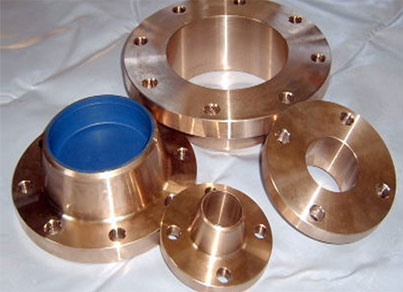
Copper Flanges
Copper flanges play a vital role in various industrial applications due to the unique properties of copper, such as excellent thermal and electrical conductivity, corrosion resistance, and antimicrobial properties. These flanges are commonly used in plumbing systems, HVAC (heating, ventilation, and air conditioning) systems, and electrical installations. Below is an overview of copper flanges, including their specifications, characteristics, and applications.
Copper Alloys: Copper alloys, such as brass (copper-zinc alloy) and bronze (copper-tin alloy), are often used in flange manufacturing to enhance specific properties like strength, corrosion resistance, and machinability.
| Specification | EN Standard | Grade | Chemical Composition | Description |
|---|---|---|---|---|
| Copper C10100 | EN 2.0090 | UNS C10100 | Ni: 0.0%, Cr: 0.0%, Mn: 0.0%, Fe: 0.05%, Si: 0.0%, Cu: Balance, C: 0.02% max | High-purity copper with excellent electrical conductivity and thermal conductivity. Used in electrical and electronic applications. |
| Copper C10200 | EN 2.0091 | UNS C10200 | Ni: 0.0%, Cr: 0.0%, Mn: 0.0%, Fe: 0.05%, Si: 0.0%, Cu: Balance, C: 0.03% max | Very high-purity copper with slightly higher conductivity than C10100. Commonly used in electronics and semiconductor applications. |
| Copper C11000 | EN 2.0092 | UNS C11000 | Ni: 0.0%, Cr: 0.0%, Mn: 0.0%, Fe: 0.35%, Si: 0.0%, Cu: Balance, C: 0.05% max | Electrolytic tough pitch (ETP) copper with good machinability and high electrical conductivity. Widely used in electrical and plumbing applications. |
| Copper C12000 | EN 2.0093 | UNS C12000 | Ni: 0.0%, Cr: 0.0%, Mn: 0.0%, Fe: 0.35%, Si: 0.0%, Cu: Balance, C: 0.05% max | Phosphor bronze with good strength and wear resistance. Used in bearings, bushings, and electrical contacts. |
| Copper C14500 | EN 2.0094 | UNS C14500 | Ni: 0.0%, Cr: 0.0%, Mn: 0.0%, Fe: 0.2%, Si: 0.0%, Cu: Balance, C: 0.03% max | High-strength copper alloy with good resistance to corrosion. Used in marine environments and high-stress applications. |
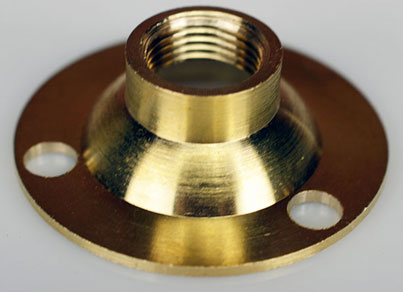
Brass Flanges
Brass flanges are widely used in various industries due to the unique properties of brass, such as corrosion resistance, machinability, and aesthetic appeal. These flanges are commonly employed in plumbing systems, marine applications, and decorative fittings. Below is an overview of brass flanges, including their specifications, characteristics, and applications.
Corrosion Resistance:
Brass exhibits excellent corrosion resistance, particularly in non-saline environments, making brass flanges suitable for plumbing and decorative applications.
Alpha Brass:
Contains more than 63% copper and is often used for general-purpose applications due to its good strength and corrosion resistance.
Alpha-Beta Brass:
Contains between 55% to 63% copper and exhibits improved machinability compared to alpha brass.
| Specification | EN Standard | Grade | Chemical Composition | Description |
|---|---|---|---|---|
| Brass C27000 | EN 2.0402 | UNS C27000 | Ni: 0.0%, Cr: 0.0%, Mn: 0.0%, Fe: 0.3%, Si: 0.0%, Cu: Balance, Zn: 90.0-93.0%, Pb: 0.0% | Commercial brass with good machinability and corrosion resistance. Used in plumbing fittings and electrical components. |
| Brass C28000 | EN 2.0403 | UNS C28000 | Ni: 0.0%, Cr: 0.0%, Mn: 0.0%, Fe: 0.2%, Si: 0.0%, Cu: Balance, Zn: 85.0-90.0%, Pb: 0.0% | Leaded brass with good machinability and moderate strength. Commonly used in precision machining applications. |
| Brass C36000 | EN 2.0401 | UNS C36000 | Ni: 0.0%, Cr: 0.0%, Mn: 0.0%, Fe: 0.2%, Si: 0.0%, Cu: Balance, Zn: 63.0-68.0%, Pb: 2.0-3.7% | Free-cutting brass with excellent machinability and good corrosion resistance. Used in automotive and aerospace components. |
| Brass C37700 | EN 2.0404 | UNS C37700 | Ni: 0.0%, Cr: 0.0%, Mn: 0.0%, Fe: 0.3%, Si: 0.0%, Cu: Balance, Zn: 61.0-65.0%, Pb: 2.5-3.5% | High-strength brass with good mechanical properties and moderate machinability. Suitable for high-stress applications. |
| Brass C38500 | EN 2.0405 | UNS C38500 | Ni: 0.0%, Cr: 0.0%, Mn: 0.0%, Fe: 0.2%, Si: 0.0%, Cu: Balance, Zn: 62.0-68.0%, Pb: 2.5-3.5% | Alloyed brass with good machinability and moderate corrosion resistance. Used in general engineering applications. |